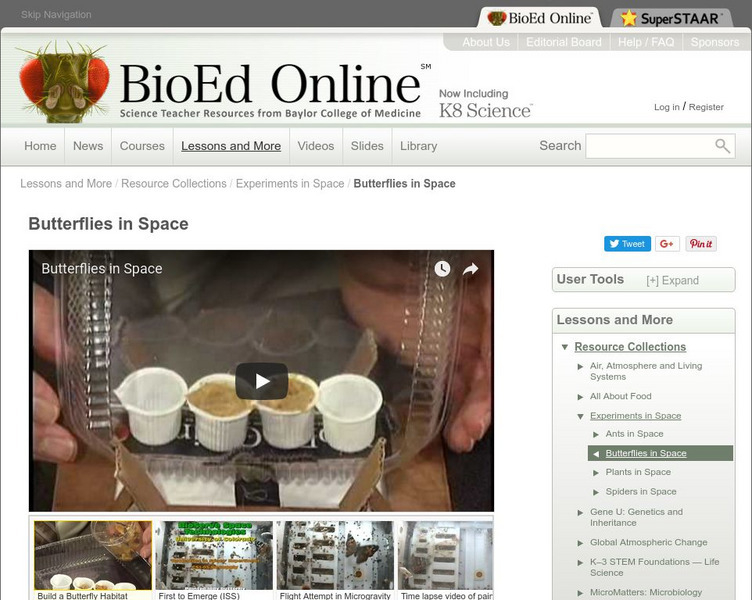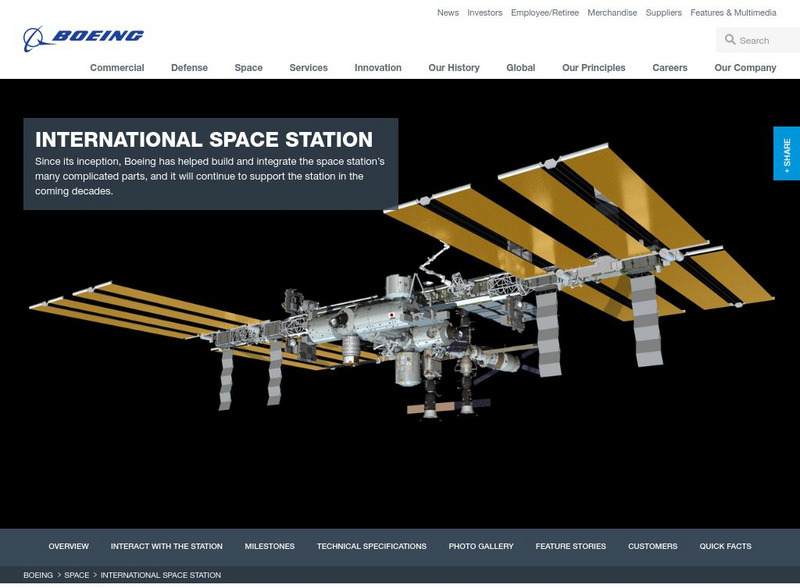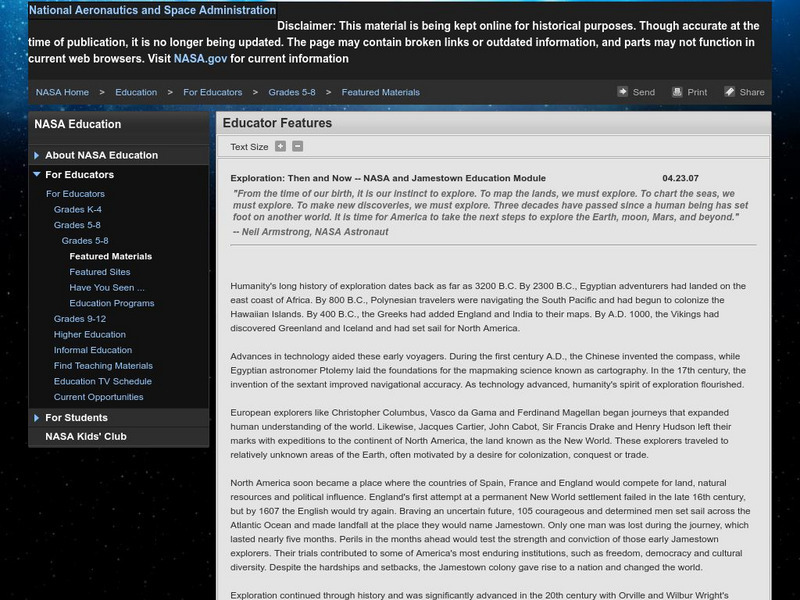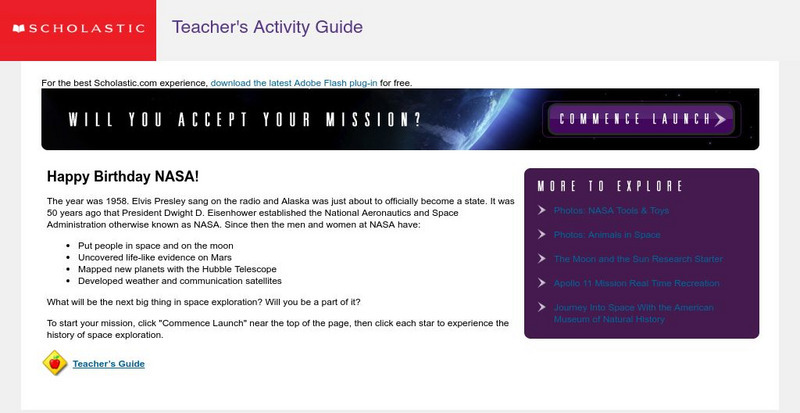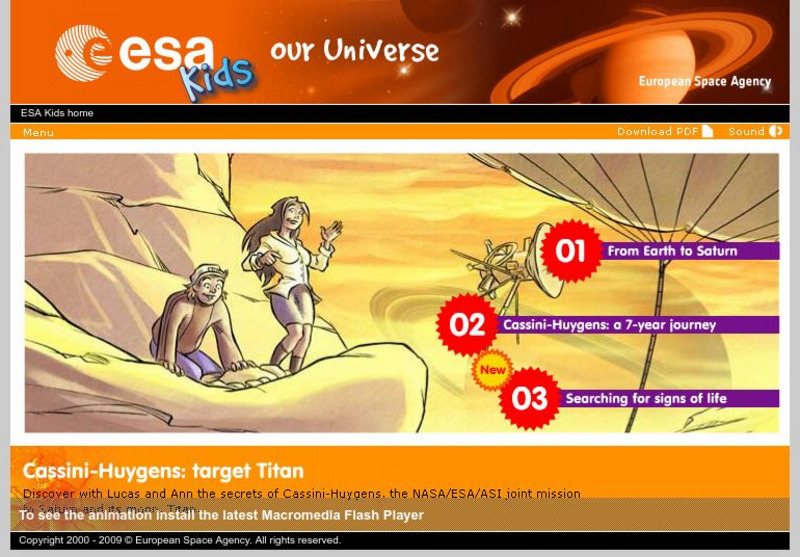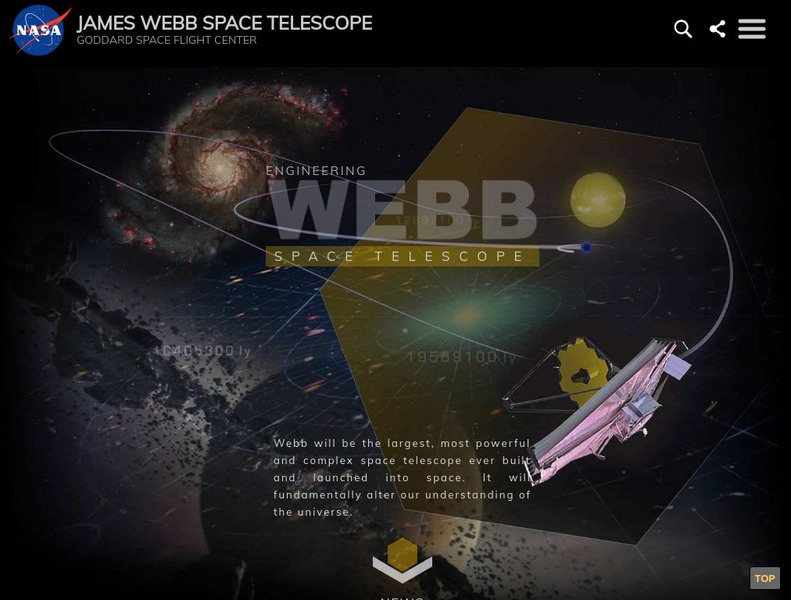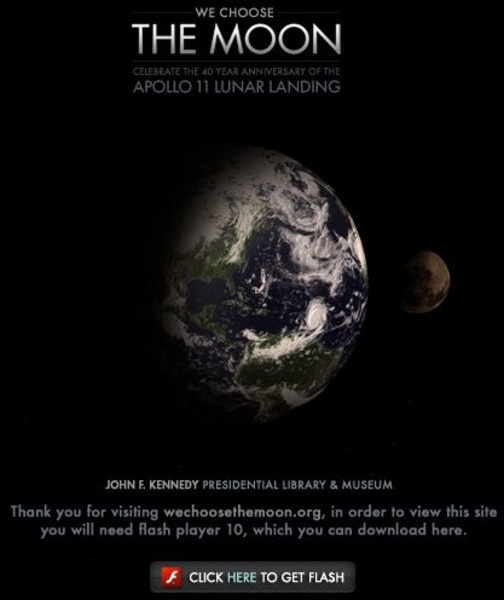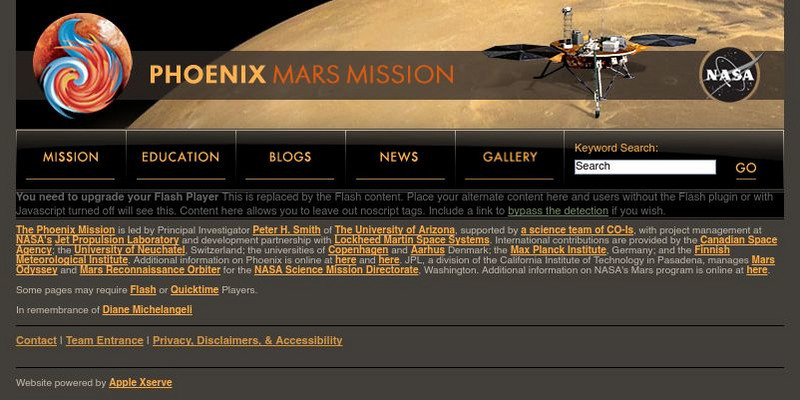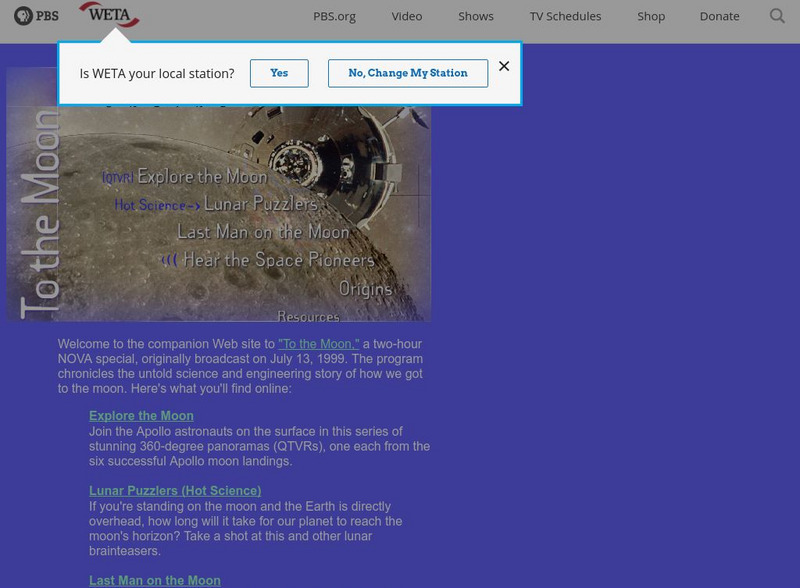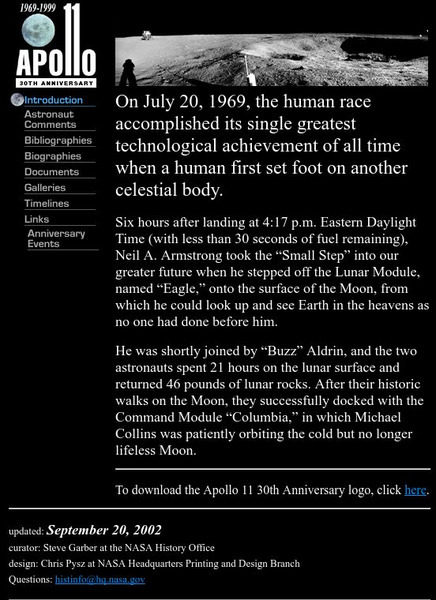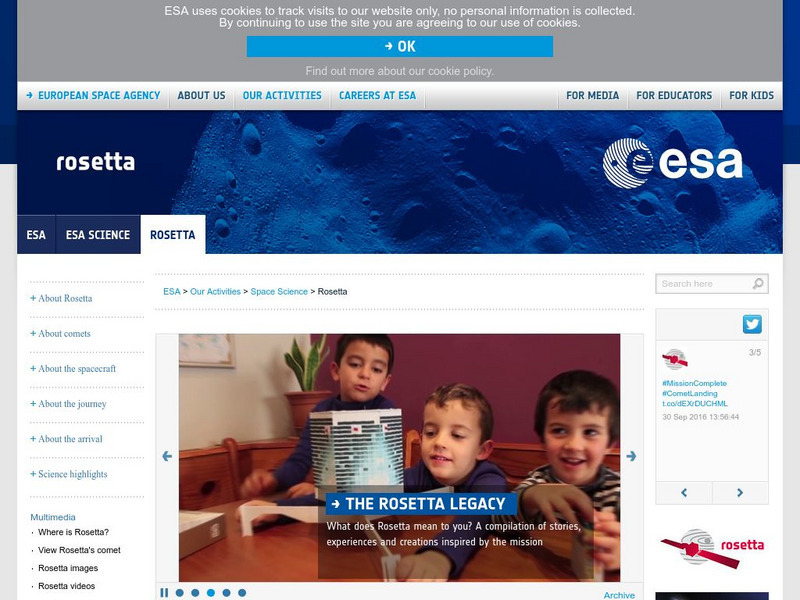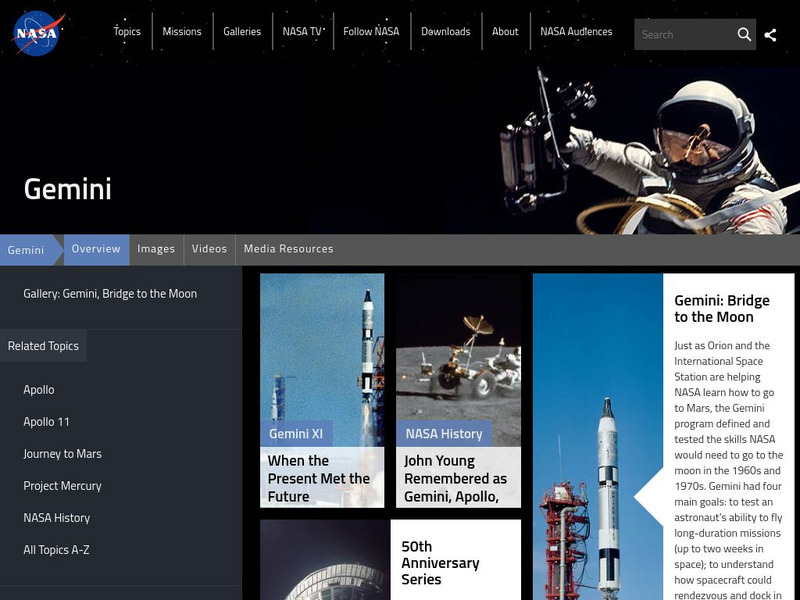Hi, what do you want to do?
Smithsonian Institution
National Air and Space Museum: Apollo to the Moon
This resource offers an in-depth exploration of the U.S. space program and the role President John F. Kennedy took in setting the agenda for manned space flight to the moon.
NASA
Jpl: Voyager: The Interstellar Mission
The Jet Propulsion Laboratory (JPL) at NASA provides a detailed history of the Voyager Project, including a description of the spacecraft and Voyager's planetary tour.
NASA
Nasa: First Space Shuttle Mission Sts 1
NASA summary of the first flight of the space shuttle Columbia in 1981.
NASA
Nasa: Cassini: Mission to Saturn
NASA site details what sets Saturn apart from the other planets in our solar system and why the Cassini spacecraft mission is important.
NASA
Nasa: 21th Century Explorer: Why Do We Want to Study and Travel to Mars?
This article answers some of the most common questions about Mars: Why is it red? Is there water on Mars? What else have scientists discovered from spacecraft that have landed there? Also, visitors can follow links to learn more about...
BioEd Online
Bio Ed Online: Butterflies in Space
In 2009, four painted lady butterflies flew aboard space shuttle Atlantis to the International Space Station, where they grew and lived. Students can use original photos from the mission to conduct open-ended scientific investigations to...
Other
Boeing: International Space Station
Boeing, the prime contractor for the International Space Station, provides a detailed overview of the station. Content focuses on the assembly sequence, mission modules, components and structure, systems, and the scientific experiments...
NASA
Nasa: Exploration: Then and Now: Nasa and Jamestown Education Module
This small collection of lesson plans introduces students to exploration by comparing the settlement of Jamestown to space missions. Find background information and links to other lesson plans.
Read Works
Read Works: A Stargazers Guide to Mission Control
[Free Registration/Login Required] An informational text about a tour of the Johnson Space Center's Mission Control room. A question sheet is available to help students build skills in reading comprehension.
Texas Instruments
Texas Instruments: Apollo Moon Missions Time Line
A time line of the Apollo space missions.
Scholastic
Scholastic: Challenging the Space Frontier
This Scholastic website offers information about space exploration. Use this site to learn about specific missions like the Friendship, Apollo 11, and STS 7. Also Dr. Mae Jemison is featured and interviewed.
PBS
Pbs: Nova: Anatomy of a Space Rover
Take a closer look at the space robots Spirit and Opportunity, and their scientific instruments used for exploring the surface of Mars.
NASA
Nasa: Space Place: I See Ice Viewer
Explore the solar system like never before with this photograph viewer. Choose the planet, then scroll through the many beautiful photographs taken by space missions. Read about how each photo shows evidence of the presence of ice.
NASA
Nasa Star Child: Space Probes to Mercury
Simple information about the first space explorer to visit Mercury. Good picture of the Mariner 10 probe. Links to a glossary of terms.
European Space Agency
European Space Agency: Esa Kids: Our Universe: Cassini Huygens
An introduction to Cassini-Huygen, a joint mission to investigate Saturn and its moon, Titan. Told in an animated comic format.
NASA
Nasa: James Webb Space Telescope
NASA's web site about the James Webb Space Telescope, which will replace the Hubble telescope and is expected to observe the farthest reaches of the universe.
TeachEngineering
Teach Engineering: Destination Outer Space
Students acquire a basic understanding of the science and engineering of space travel as well as a brief history of space exploration. They learn about the scientists and engineers who made space travel possible and briefly examine some...
Other
Space Exploration: History
Here is an article explaining how the Skylab idea and program came about.
Other
We Choose the Moon
Feel like you were right there when Apollo 11 was launched as you listen to the actual Mission Control audio from that date. The mission is further brought to life by photos and video of the event as well as a virtual animation. Go...
University of Arizona
Nasa: The History of Mars Exploration
Explore the time line from 1960 to the 2000s about Mars Missions. Choose from news, explorations, blogs, gallery, and missions to learn more about Mars exploration.
PBS
Nova: To the Moon
This companion website of a NOVA program that aired in 1999 features extensive information that focuses on moon research and includes a history of the Apollo missions as well as the science of the moon's origins.
NASA
Nasa: 1969 1999: Apollo 30th Anniversary
A special anniversary site for the Apollo 11 mission to the moon. Complete with comments from the astronauts, galleries with many images related to the mission, and much more.
European Space Agency
Esa Rosetta
This complete overview of the Rosetta mission is a fantastic source that is updated for every new discovery or happening during the mission. Additional links to a multimedia gallery, and to learn about the team that is working on the...
NASA
Nasa: Gemini: Stepping Stone to the Moon: 40 Years Later
On the 40th anniversary of the launch of Gemini XII, NASA offers a comprehensive overview of the manned space flight program that was the first to include two-man spacecraft and was designated Gemini in 1962.
Other popular searches
- Space Missions Satellites
- Apollo Space Missions
- Us Space Missions
- Plutos Space Missions
- U.s. Space Missions
- Space Missions to the Moon









